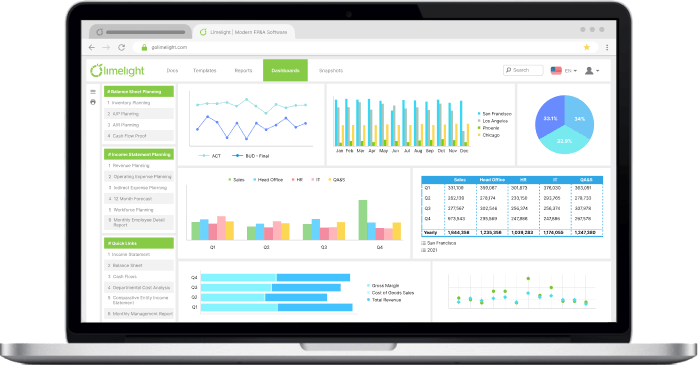Financial Planning & Analysis
10 Best EPM Software for Forecasting, Budgeting & Analytics in 2025

By Jade Cole |
Published: November 05, 2024

By Jade Cole |
Published: November 05, 2024
Choosing the wrong enterprise performance management (EPM) software means your team will spend months implementing a system, only to discover it doesn’t fully integrate with your current tools.
Data will not sync properly, workflows will be disrupted, and employees will have a complex, unintuitive interface. Instead of improving performance, you will be stuck in delays and troubleshooting.
Choosing the right EPM software from the start can easily avoid this costly mistake. The right solution will not only integrate smoothly into your existing systems but also deliver real-time insights, streamline operations, and support long-term growth.
To ensure you make the right choice, look for EPM software with these key features:
In this article, we will look at the best enterprise performance management software to help you choose the right solution for your business.
Here’s an overview of top EPM software solutions in 2025:
|
Tool |
Ease of Use |
Implementation |
Ability to Integrate |
USP |
|
Limelight |
User-friendly, no-code platform suitable for teams with varying skills |
Quick adoption due to intuitive interface and real-time updates |
Seamless integration with ERP, CRM, HR systems |
No-code platform that supports flexible financial modeling and planning |
|
Anaplan |
Highly customizable, but requires technical skills |
Lengthy implementation; customizations can take weeks to over a year |
Strong integration with enterprise systems, but technical expertise required |
Advanced connected planning for large enterprises, offering real-time insights and complex scenario modeling |
|
Jedox |
Familiar Excel-like interface, but customization is complex |
Smooth for Excel users, but advanced customizations require technical knowledge |
Extensive connectors and ETL tools for Excel and other data sources |
Hybrid solution bridging Excel familiarity with advanced EPM capabilities |
|
Datarails |
Easy to use, built on Excel i |
Quick and simple implementation |
Limited integration beyond Excel |
Automates financial workflows while retaining Excel |
|
Pigment |
Intuitive, but some users find features complex |
Quick implementation, but end users face challenges with advanced features |
Integrates with various business tools, but integration is still evolving |
Collaborative, real-time planning tool with strong data visualization and scenario modeling |
|
Oracle EPM Cloud |
Complex navigation, steep learning curve |
Time-consuming setup, especially for tax reporting and other advanced features |
Seamless integration with Oracle ecosystem |
Comprehensive suite for large enterprises with powerful scenario modeling and reporting tools |
|
OneStream |
Difficult to navigate for non-technical users |
Steep learning curve, especially for advanced functionalities like extendable dimensionality |
Flexible metadata management and integration with multiple EPM processes |
Unified platform for all EPM needs, providing deep consolidation and analytics capabilities |
|
Workday Adaptive Planning |
User-friendly interface, but performance issues with large datasets |
Requires expertise for setup, but intuitive once implemented |
Integrates with any ERP, supports extensive data consolidation |
Flexible planning tool with strong scenario modeling and workforce planning |
Limelight is an intuitive, no-code FP&A software with robust EPM capabilities designed for easy adoption by teams of varying technical skill levels.
With its user-friendly interface, Limelight enables organizations to streamline financial planning, budgeting, and forecasting without the need for extensive coding knowledge. It integrates seamlessly with various ERP, CRM, and HR systems, ensuring that teams can access updated, relevant data in real-time.
So, for teams looking for ease of use and integration, Limelight stands out as a practical solution.
You can start with as few as 5 users for $1,400 per month, after which you can get a custom quote based on your needs and scale.
Anaplan is a cloud-based FP&A platform known for its strength in connected planning and delivering real-time insights across finance, operations, and sales.
Its ability to unify business planning across departments helps organizations respond quickly to changes with dynamic, cloud-based modeling capabilities. Its advanced analytics, scenario modeling, and flexible customization options make it a suitable option for businesses looking to enhance agility in their decision-making processes.
However, Anaplan’s high cost makes it unfavorable for smaller organizations or those with tighter budgets. Its premium features cater well to large enterprises with complex planning needs.
Not available online, contact the Anaplan sales team.
Jedox offers a hybrid solution, combining the familiarity of an Excel-like interface with advanced EPM capabilities for budgeting, planning, and forecasting.
Jedox’s ability to integrate with existing data structures appeals to companies that prefer working in Excel but need more powerful tools for automation and analytics. It is highly customizable, allowing them to tailor it to their specific needs.
However, this customization is complex and requires technical expertise to fully optimize the solution. For users comfortable with Excel but seeking an EPM upgrade, Jedox offers a smooth transition to more advanced functionalities.
Jedox offers four main subscription plans:
Datarails enhances Excel by automating and improving financial planning processes while keeping the familiarity of Excel’s interface intact. Its strong automation capabilities help finance teams streamline workflows, from budgeting and forecasting to reporting, without abandoning the widely used Excel platform.
Related Reads: Top 10 Business Budgeting Software for Startups, SMBs, and Enterprises in 2024
However, Datarails has limited integration with non-Excel systems, restricting companies looking for broader system connectivity. For businesses seeking to improve efficiency without moving away from Excel, Datarails offers a valuable, easy-to-use solution.
Datarails pricing is customized based on the specific needs of the business, contact sales team for a quote.
Pigment is a collaborative planning tool that facilitates easy-to-use, real-time financial planning and analysis. Its user-friendly interface provides businesses with an intuitive way to handle data visualization, scenario modeling, and forecasting. Its collaborative environment ensures that teams can interact in real-time, driving more informed decision-making.
However, as a newer entrant to the EPM market, Pigment lacks the maturity of older, more established competitors, but it continues to build a reputation for its simplicity and strong collaboration features. It’s a compelling option for organizations looking to modernize their planning processes with an easy learning curve.
Pigment offers three pricing plans, but specific details are not publicly available.
Oracle EPM Cloud offers a comprehensive suite of tools designed for large enterprises to manage budgeting, forecasting, and financial reporting. It offers powerful tools for managing complex business processes and extensive reporting capabilities, making it ideal for enterprises with diverse needs.
However, the platform’s high cost is a barrier for smaller businesses or organizations with limited budgets. Nonetheless, Oracle remains a top contender for companies seeking enterprise-grade EPM solutions.
The cost varies significantly depending on the modules and features required. Contact Oracle directly for a detailed and tailored quote.
OneStream is a unified enterprise performance management platform consolidating multiple EPM processes, such as financial planning, reporting, and analytics, into a single solution.
However, this comprehensive feature set also contributes to a steep learning curve.
Related Reads: 10 Best Financial Analysis Software in 2025 for Your FP&A Team
OneStream’s pricing starts at around $150,000, which is based on usage, meaning costs vary depending on the specific needs and scale of the business.
There is no free trial or free version available, so you have to contact OneStream directly for a detailed and customized quote.
Adaptive (Workday Adaptive Planning) is a cloud-based EPM solution known for its user-friendly interface and flexibility in budgeting, forecasting, and financial reporting. The platform is designed to help teams quickly adapt to changes in business conditions with real-time planning and modeling capabilities. It allows organizations to plan more effectively across finance, operations, and HR.
However, users have reported performance issues when working with large datasets, which slows down planning and analysis processes. Despite this, Workday remains a popular choice for businesses seeking an accessible EPM tool focusing on ease of use.
Workday Adaptive Planning offers two plans —
The basic plan comes with a 30-day free trial, and you can request a quote for either option based on your requirements.
Vena leverages the familiarity of Excel to deliver a powerful EPM solution for budgeting, planning, and reporting. With its Excel-based interface, Vena allows users to perform complex financial tasks without having to learn a new platform. It offers advanced automation features, making it easier to manage large amounts of data and generate reports quickly.
However, Vena’s heavy reliance on Excel is limiting for users looking for a more modern, web-based solution. For organizations that want to stick with Excel but need enhanced EPM capabilities, Vena offers a practical and familiar solution.
Vena Solutions has two plans — Professional and Complete.
The Complete plan includes all the features of the Professional plan, such as full Microsoft Excel integration and reporting and analytics, along with additional features like Vena Insights premium support. You can request a custom quote for each plan.
Get more details about each Vena pricing plan here.
Prophix is an integrated platform for budgeting, planning, and financial consolidation designed to simplify complex financial processes. Its strong automation and reporting capabilities help businesses streamline workflows and enhance the accuracy of their financial data.
However, users find the interface outdated compared to more modern EPM solutions (like Oracle EPM Cloud, Pigment, and OneStream), which affects user experience. It’s an ideal solution for mid-sized businesses looking to move beyond manual financial processes.
Prophix’s pricing is not publicly available.
When finance, operations, and other departments collaborate, they create a comprehensive view of performance that facilitates better decision-making. However, many EPM solutions complicate this collaboration with a steep learning curve.
Excel-based solutions, in particular, are challenging to manage due to versioning issues and limited real-time interaction. These difficulties create silos, preventing teams from working with the most current information.
Limelight effectively addresses these collaboration challenges by integrating with a wide range of CRM, HRIS, and ERP systems, ensuring updated data is always available. With built-in security, version control, and commenting features, Limelight enables teams to work together seamlessly and securely, enhancing communication and ensuring everyone is aligned.
Enterprise performance management doesn’t have to be a struggle—book a demo to discover how Limelight can transform your EPM experience!
EPM software is designed to streamline financial and operational management by integrating data across systems like ERPs and CRMs, automating processes such as budgeting, forecasting, and scenario analysis, and enabling real-time insights for strategic decision-making.
Key features to look for include:
Seamless integration with existing ERPs, CRMs, and systems
A user-friendly interface for easy adoption
Timely and accurate financial reporting
Scalability to grow with business needs
Capabilities in forecasting, budgeting, and scenario planning
Limelight stands out for its intuitive, no-code interface that supports easy financial modeling and real-time data updates. It integrates smoothly with ERP, CRM, and HR systems, enabling flexible planning and forecasting for teams across skill levels.
Anaplan: Highly customizable and powerful, but complex to implement and best suited for large enterprises.
Jedox: Familiar Excel-like interface, but advanced configurations require technical knowledge.
Datarails: Easy Excel-based automation, yet limited system integration.
Workday Adaptive Planning: User-friendly and flexible—but may struggle with large datasets.
Oracle EPM Cloud and OneStream: Feature-rich and enterprise-focused, but complex and resource-intensive to deploy.
Limelight starts at $1,400 per month for five users, with flexible pricing available beyond that based on the number of users and business requirements.
Subscribe to our newsletter


